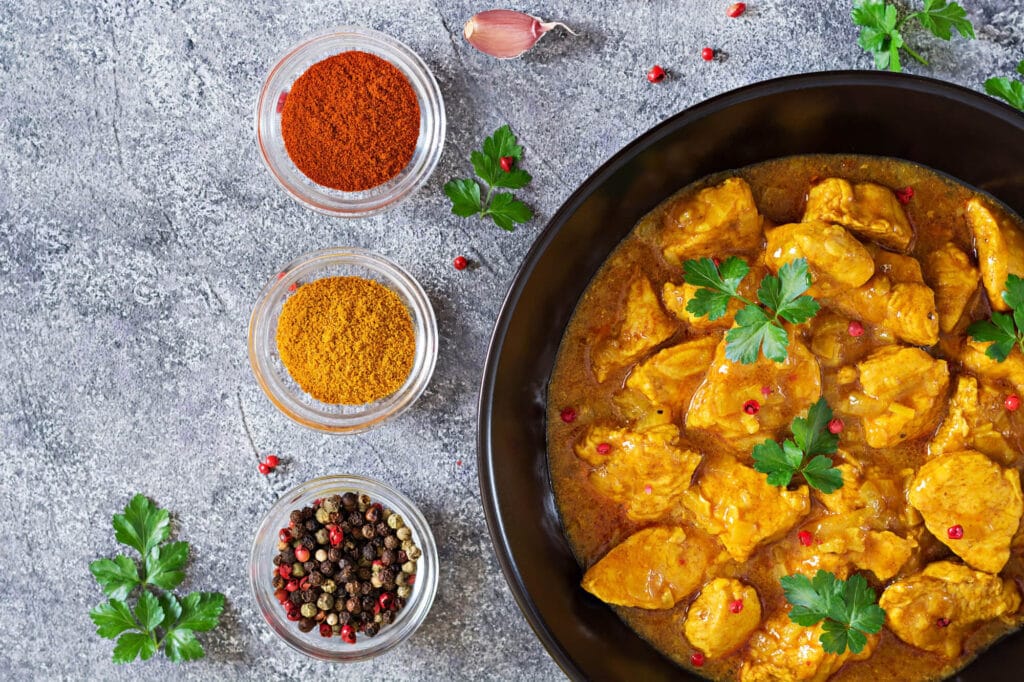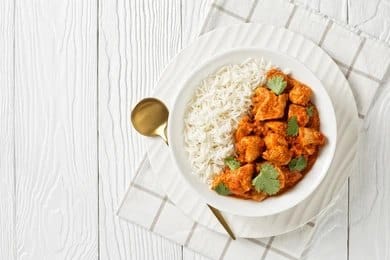Introduction Of Butter Chicken
Butter chicken, also known as Murgh Makhani, is one of the most popular Indian dishes worldwide. Its creamy texture, rich flavor, and tantalizing aroma make it a favorite in many households and restaurants. However, when discussing its health implications, the question arises: Is butter chicken healthy?
This article explores the nutrition, key ingredients, and possible health benefits or downsides of butter chicken. By learning about its ingredients and calorie content, you can make better food choices while still enjoying this popular dish. Focusing on balanced nutrition, portion sizes, and the benefits of spices, we aim to provide clear answers about whether butter chicken can be a healthy option.
Nutritional Breakdown of Butter Chicken
Butter chicken contains a variety of ingredients that contribute to its unique taste and nutritional profile. To evaluate Is butter chicken healthy?, it’s essential to examine its macronutrient composition:
- Protein: Chicken is the primary protein source, making butter chicken a high-protein dish.
- Fats: Butter and cream provide a significant amount of saturated fats, which, in excess, can contribute to health issues.
- Carbohydrates: Minimal in the dish itself but can increase significantly when paired with naan or rice.
- Vitamins and Minerals: The spices in butter chicken offer antioxidants and other micronutrients like vitamin A, vitamin C, and iron.
While the nutritional breakdown highlights both benefits and drawbacks, moderation and mindful eating are crucial to enjoying butter chicken as part of a healthy diet.
For flavor inspirations, check out our recommendations for butter and chicken flavor pairings.
Key Ingredients in Butter Chicke
The key to understanding Is butter chicken healthy? lies in its ingredients. Let’s break them down:
Chicken
- A lean protein source, providing essential amino acids for muscle repair and maintenance.
- Low in carbohydrates, making it suitable for low-carb diets.
Butter and Cream
- Contribute to the creamy texture but are high in saturated fats.
- While small amounts can be part of a healthy diet, excessive consumption may lead to weight gain or elevated cholesterol levels.
Tomatoes
- The base of the sauce, rich in lycopene, a powerful antioxidant.
- Low-calorie and nutrient-dense, adding flavor without unnecessary calories.
Spices
- Spices like turmeric, cumin, coriander, and garam masala add flavor and also help reduce inflammation and protect the body with antioxidants.
Each ingredient has its own benefits, but the way you prepare the dish and how much you eat are key to deciding how healthy it is.
Protein Benefits from Chicken
When asking Is butter chicken healthy?, the protein content is one of its strengths. Here’s why:
- Muscle Growth and Repair: Chicken is a complete protein, offering all essential amino acids needed for muscle repair and growth.
- Satiety: High-protein foods promote fullness, reducing overall calorie intake.
- Weight Management: Lean chicken breast can support weight loss efforts due to its low-fat content compared to other protein sources.
However, the health benefits can diminish if the chicken is heavily fried or cooked with excessive oils. Opting for grilled or baked chicken is a healthier choice when preparing butter chicken.
Impact of Butter and Cream
The rich taste of butter chicken comes from its butter and cream content. But do these ingredients compromise its healthiness? Here’s what to consider:
- Butter: A source of energy but high in saturated fats. Overconsumption may increase the risk of heart disease.
- Cream: Adds a smooth texture but is calorie-dense, making it a less ideal choice for weight management.
To make butter chicken healthier, consider:
- Replacing heavy cream with low-fat yogurt or coconut milk.
- Using less butter or opting for alternatives like ghee, which contains healthy fats.
These small adjustments can significantly reduce the calorie and fat content without sacrificing flavor.
Spices: Flavor and Health Benefits
Spices are the heart of butter chicken and play a vital role in determining Is butter chicken healthy? Their health benefits include:
- Turmeric: Helps reduce inflammation and protects the body with its antioxidant properties.
- Cumin: Supports digestion and can help improve metabolism.
- Coriander: Packed with vitamins C and K, it boosts the immune system and strengthens bones.
- Garam Masala: A mix of spices that aids digestion and helps lower inflammation in the body.
Using these spices in butter chicken not only improves its taste but also adds important nutrients. However, store-bought spice mixes can have a lot of salt, so creating your own spice mix at home is a better and healthier option.
Calorie Content and Portion Control
When discussing Is butter chicken healthy?, calorie content is a crucial factor. On average:
- A single serving of butter chicken contains 400-500 calories.
- Pairing it with naan or rice can add another 200-300 calories per serving.
To enjoy butter chicken without overindulging:
- Stick to smaller portions.
- Pair it with whole-grain options like brown rice or quinoa.
- Include a side of fresh vegetables to balance the meal.
By practicing portion control, you can savor the flavors of butter chicken while maintaining a balanced diet.

Comparing Restaurant vs. Homemade Versions
When considering Is butter chicken healthy?, it’s important to differentiate between restaurant and homemade versions. Each has distinct characteristics that influence its nutritional value.
Restaurant Butter Chicken
- Often uses a lot of butter, cream, and oil to improve taste and make it richer.
- Usually has more calories and salt because of the ingredients used in restaurants.
- Servings are bigger, which can make it easy to eat too much.
Homemade Butter Chicken
- Lets you control the amount and quality of the ingredients.
- You can choose healthier options like low-fat yogurt or olive oil instead of cream or butter.
- Homemade versions often have less salt and fewer unhealthy fats.
While restaurant butter chicken is easy to get and has a rich taste, the homemade version lets you better control its nutrition. Making it at home helps you enjoy the flavors while staying healthy.
Making Butter Chicken Healthier
The question Is butter chicken healthy? largely depends on how it’s prepared. Small modifications can significantly improve its healthfulness.
- Use Leaner Cuts of Chicken: Opt for skinless chicken breast instead of thighs to reduce fat content.
- Reduce Butter and Cream: Substitute heavy cream with low-fat yogurt or coconut milk.
- Incorporate More Vegetables: Add spinach, bell peppers, or peas for added fiber and nutrients.
- Control Oil Usage: Use non-stick pans to minimize oil requirements during cooking.
- Limit Salt: Replace some salt with herbs or spices for flavor enhancement without added sodium.
These changes not only make butter chicken healthier but also help it fit easily into a balanced diet.
Balancing Butter Chicken in Your Diet
When asking Is butter chicken healthy?, it’s important to understand its role in your overall diet. Butter chicken, when consumed in moderation, can be part of a balanced meal plan.
- Portion Control: Stick to a serving size of about 1 cup to keep calorie intake in check.
- Pair with Healthier Sides: Choose whole grains like brown rice or quinoa instead of naan or white rice.
- Frequency: Limit butter chicken to occasional meals rather than a daily staple.
- Complement with Vegetables: Serve with a side of steamed vegetables or a salad to add fiber and nutrients.
By pairing butter chicken with other healthy, nutrient-rich foods, you can enjoy its rich taste without affecting your health goals.
Pairing Suggestions
The right pairings can enhance the flavor of butter chicken while maintaining a healthy balance. For those wondering Is butter chicken healthy?, pairing it wisely is key.
- Whole Grains: Serve with brown rice, quinoa, or millet for a fiber-rich alternative to white rice.
- Vegetable Sides: Pair with roasted broccoli, cauliflower, or a cucumber-tomato salad for added vitamins and minerals.
- Low-Calorie Flatbreads: Swap naan for whole-wheat roti or tortilla to reduce calorie intake.
- Yogurt-Based Dips: Add a raita made with low-fat yogurt, cucumber, and mint to cool the palate and provide probiotics.
These combinations not only enhance the meal’s nutritional value but also help balance the richness of butter chicken.
Common Misconceptions
When debating Is butter chicken healthy?, several misconceptions can arise. Let’s debunk a few:
- Myth 1: Butter chicken is inherently unhealthy.
Fact: With mindful ingredient choices and portion control, it can fit into a healthy diet. - Myth 2: Homemade versions lack flavor.
Fact: Spices and fresh ingredients ensure homemade butter chicken tastes just as delicious as the restaurant version. - Myth 3: Butter chicken cannot be made dairy-free.
Fact: Substituting butter with ghee and cream with coconut milk makes it a viable option for those avoiding dairy.
Addressing these misconceptions shows that butter chicken can be a flexible and healthier option.
Benefits of Traditional Cooking Methods
Traditional methods of preparing butter chicken can contribute to its health benefits. To understand Is butter chicken healthy?, it’s important to consider the cooking techniques.
- Slow Cooking: Enhances flavor while allowing the spices to release their antioxidant properties.
- Marination: Yogurt-based marinades tenderize the chicken and infuse it with flavor, reducing the need for additional fats during cooking.
- Minimal Processing: Traditional methods often rely on fresh, whole ingredients, which are richer in nutrients compared to processed alternatives.
By sticking to traditional cooking methods, you can maximize both the taste and health benefits of butter chicken.
Frequently Asked Questions
1. Is butter chicken healthy for weight loss?
Butter chicken can be part of a weight-loss diet if made carefully. It is often high in calories because of butter and cream, but you can replace these with low-fat yogurt or coconut milk to lower the calorie count. Using lean chicken, like skinless chicken breast, also reduces fat. Portion control is important—stick to about 1 cup per serving. Pair it with whole grains or vegetables to make your meal balanced and more nutritious.
2. Is butter chicken gluten-free?
Yes, butter chicken is naturally gluten-free if the recipe does not include ingredients like thickeners or additives that contain gluten. Traditional recipes are made with yogurt, cream, and spices, which do not have gluten. However, if you are ordering butter chicken at a restaurant, it is a good idea to ask if they use wheat-based thickeners or flour in the sauce to be sure.
3. Can I make butter chicken dairy-free?
Yes, butter chicken can be made dairy-free by replacing cream with coconut milk or cashew cream. Instead of butter, you can use ghee (if it works for your diet) or plant-based oils like olive oil or avocado oil. These swaps keep the creamy texture and rich taste while making it a good choice for people who avoid dairy.
4. How often can I eat butter chicken?
Butter chicken is best enjoyed in small amounts, especially if it’s made with butter and cream. To keep your meals healthy, try eating it only once or twice a week. Serve it with fiber-rich vegetables or whole grains like brown rice to make it better for you. Avoid eating it with high-calorie sides like naan or white rice to avoid extra calories.
Conclusion
So, is butter chicken healthy?
It depends on how it’s made, the ingredients you choose, and how much you eat. Traditional butter chicken is rich and full of flavor, but simple changes can make it healthier without losing its taste. Cooking it at home, adding vegetables, and serving it with whole grains can turn it into a balanced and filling meal.
The key is to enjoy it in moderation, pay attention to the ingredients, and try healthier swaps. With these tips, butter chicken can be both delicious and better for your health.


